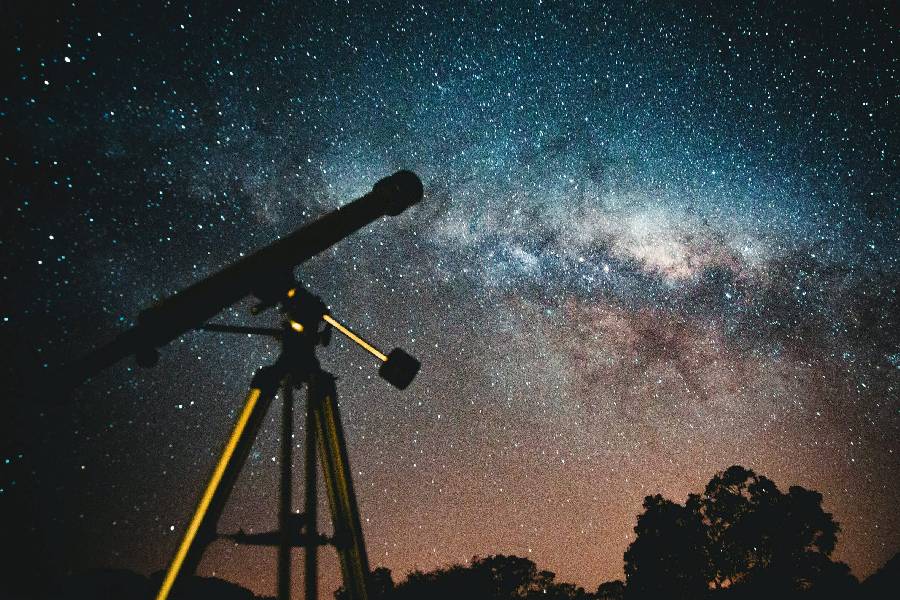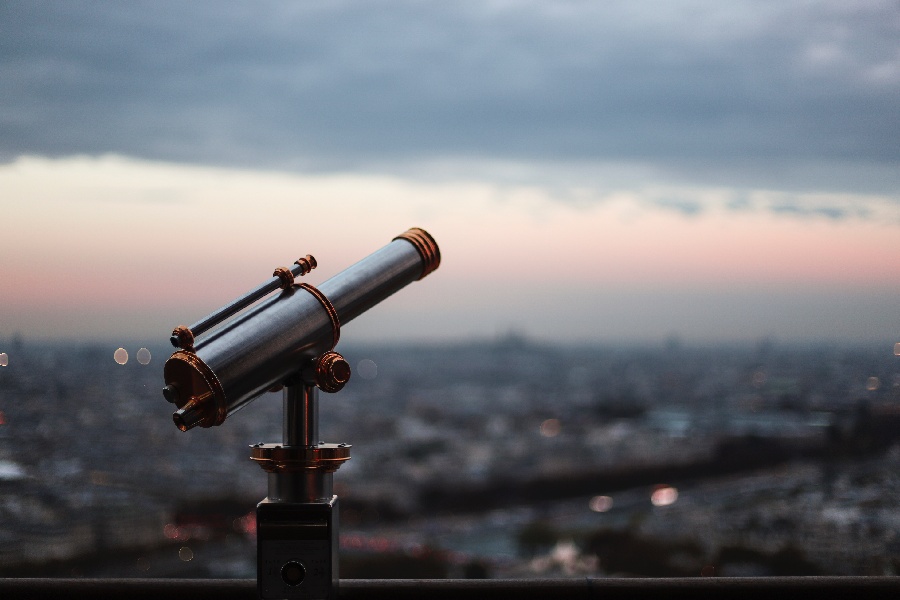Telescopes unveil unseen galactic glories, fueling the imagination of worlds beyond our dreams. But peering past the veil of space relies upon profound physics. So, how do telescopes work to enhance our sight so far? Why do we use telescopes?
This guide will decode the inner workings of telescope technology. It will explain the optical physics of electromagnetic waves and the ingenious mechanisms in enlarging our galactic view.
We will also dive into the skill and artistry required to shape mirrors that precisely direct photons from distant stars manually. Let’s unravel the mystery behind the working of our telescopes.

How Do Telescopes Work?
First, what is a telescope? It is an optical instrument that gathers and magnifies light, allowing distant objects in the sky, such as stars and planets, to be observed more clearly. Telescopes operate by collecting and magnifying light, allowing astronomers to observe distant celestial objects more clearly.
But how does a telescope use light? The basic principles of telescope operation involve gathering light through a primary lens or mirror, its concentration, and then the magnification of the resulting image. There are two main types of telescopes, refracting and reflecting, which achieve these processes through distinct mechanisms.
Refracting telescopes
- Utilize lenses to bend and focus light.
- Have an objective lens at the front, which gathers and refracts incoming light.
- Eyepieces magnify the focused image for observation.
Reflecting telescopes
- Use mirrors to capture and reflect light.
- Employ a primary curved mirror to collect and reflect light to a focus point.
- Eyepieces or additional mirrors magnify the final image for observation.
Reflector Telescopes
Mirror optics fundamentals
Reflector telescopes gather light using curved primary mirrors instead of lenses to focus rays by reflection. The concave dish shape converges beams toward a central focal point.
A second smaller secondary mirror mounted ahead then diverts concentrated light out the side of the instrument tube to an eyepiece. Avoiding light passage through glass removes chromatic aberration seen in refractors.
Technical capabilities and uses
- The ability to scale to very large diameters, which is impossible with solid lenses.
- Enables unmatched light grasp and detail resolution.
- Ultra lightweight ribbed mirror backing structures.
- Retain precision shape while minimizing weight.
Refractor Telescopes
Construction and workings
Refractors focus light through an objective front lens, feeding gathered beams into the optical tube path. Entering rays encounter shaped glass to bend pathways toward a pre-calculated focal point.
At this focal point, the pathways are bent to magnify the image. Magnified eyepieces then further expand details into the observer’s widened exit pupil.
Furthermore, objective lenses come in various designs, like convex, achromatic, and apochromatic. These counteract chromatic effects that spread out wavelengths. Specifically, the achromatic and apochromatic lenses reduce color blurring from different wavelengths, focusing on slightly different spots.
Additionally, mounts need to support telescopes firmly. This stable platform keeps celestial objects steady in view. Mount sizes range from small 60mm Galileoscopes to large 600mm+ astrographs at big observatories. But pure glass lenses can only get so big before distortions happen.
Optical principles
The core refractive concepts involve using converging lens elements. These lens elements are often treated with substrates. They divert incoming photons by different degrees. These degrees depend on glass-interface angles along varying peripheral zones.
The resulting focal point is created as rays curve into a temporary meeting apex. This focal point allows controllers to scan regions or subjects of interest. Then, the column exists oculars toward awaiting retinas. As a result, the scene has been greatly expanded and focussed. This focus is unlike previous naked perceptions.
Additional optical filters narrow desired bandwidths. By precisely shaping glass surfaces using calculated techniques, scenes in both day and night become clearer and more detailed.

Understanding Compound Telescopes
Integrating reflecting and refracting elements
Compound telescopes merge design properties found in both refracting and reflecting telescopes. This hybrid aims to balance the strengths of lens and mirror elements, directing and focusing beams of light into human-viewable final images.
Also, objective lenses and curved mirrors guide light along the optical path. Thanks to advanced glass and coatings, the converging rays pass through eyepieces, creating clear views.
Customization across needs
Skillfully combining essential elements, including robust refractive secondary mirrors and open architecture mirrors with broad diameters, enhances diffraction limits and versatility. This design caters to a spectrum of requirements, from the budget-conscious backyard hobbyist to exclusive astrograph setups in leading global research observatories.
Radio Telescopes
Unraveling radio telescopes
Shifting from visible light-gathering optics, radio telescopes focus on detecting longer wavelength radio wave frequencies streaming invisibly across the universe. Their four critical elements are:
- Huge parabolic dish antennas
- Radio receivers (feeds) at the focal point
- Low-noise signal amplifiers
- Data recording/processing systems
Rather than eyes, creative technologies expand observational horizons into new spectra. This is akin to radically enhanced hearing, revealing what roars silently in space by tuning into strange radio vibrations.
Revealing the invisible universe
Radio astronomy offers a unique vision of stellar ecosystems. Observed radio signatures unlock dynamic physics from pulsars, quasars, masers and the earliest hydrogen. Signals otherwise lost amid visible rays’ paths now emerge.
As strings between eras, radio waves hint back toward the Cosmic Dawn when the first atoms forged, carrying information we stretch to collect today. Much as antennae existing for transmission now more critically receive, dish sizes also grow across barren lands – pointing ears, not voices, toward the outer unknowns.
Mirrors in Reflectors
Primary and secondary mirrors
The core optics of reflectors involve huge concave parabolic or spherical primary mirrors to gather and focus light. Coming to a point at the central focal point, a smaller convex secondary mirror ahead reflects concentrated rays. This secondary mirror then reflects the concentrated rays out the side of the telescope tube structure into awaiting detectors and eyepieces.
Optimized properties
Primary mirrors span from 1-meter hobbyist sizes to 10+ meter giants at national observatories. Telescopes use sturdy materials like borosilicate glass, ceramic, aluminum, and Zerodur quartz glass-ceramic substrates.
These materials balance durability and thermal expansion. So, the telescope’s surfaces are finely polished, and coatings redirect photons for clear observation.
The role of the secondary mirror
The secondary mirror plays a crucial role. It intercepts the tightly bundled beams gathered by the primary mirror. It then diverts these beams sideways into scientific instruments or viewer optics. This is done rather than allowing the beams to escape through the bottom.
Moreover, precise secondary cutting, alignment, and rigging make photons follow the intended tracts. Sometimes, secondaries are articulated via robotic positioners, enabling steering incoming rays across varied housed devices.
Conclusion
How do telescopes work? The aim of a telescope is collecting and focusing light to observe the distant – while drawing that cosmos closer through glass and mirrors.
As we continue developing advanced telescopes, the quest to explore the unseen universe echoes the early days when telescopes used curved glass to expand our view. Today’s cutting-edge instruments, like massive chilled dish arrays, unveil the ancient light from the earliest galaxies.
In essence, telescopic capabilities push new frontiers of engineering. However, the core human passion for peering beyond what our naked eyes see persists through generations.
